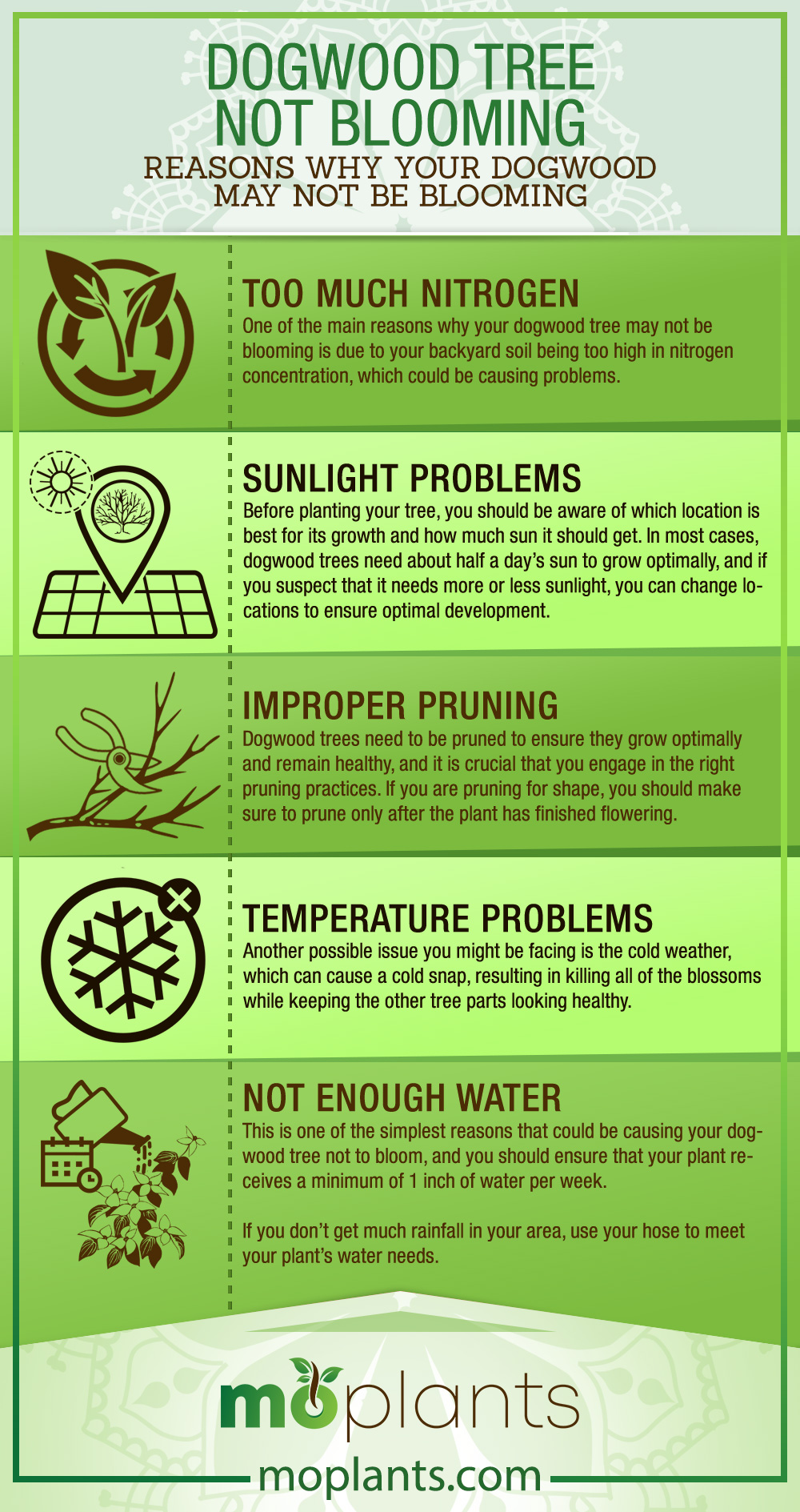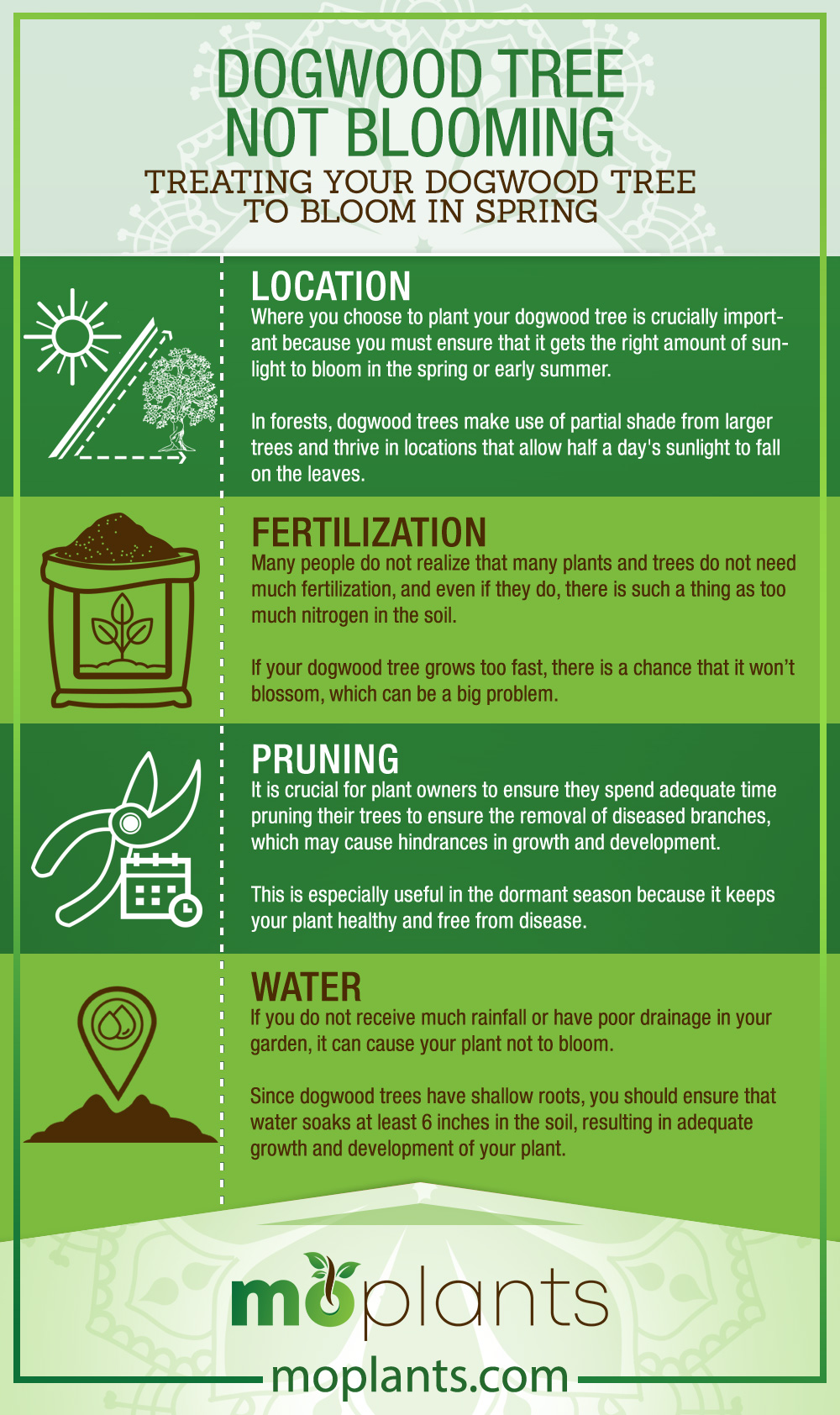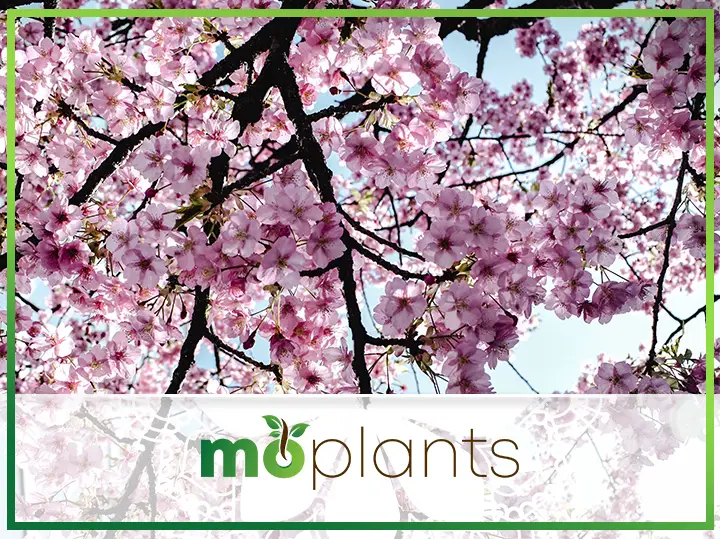Dogwood trees produce beautiful flowers that bloom in the springtime, and it can be highly frustrating to discover that your tree is not blooming at all, despite looking healthy.
There are many reasons why this could be the case, and it helps to do your research and familiarize yourself with what this particular tree needs to bloom.
You’re probably curious about when you will begin seeing the stunning dogwood bloom, and we’ve compiled some easy fixes you can implement today to give your dogwood tree the best fighting chance for blooming in spring.
Let’s explore everything you need to know about the dogwood tree.
The Flowering Dogwood Tree
Dogwood trees are short and flowering trees that are typically found in the eastern United States.
Their heights can vary depending on the cultivar, but these trees can grow up to 30 feet long on average.
After reaching its maturity, the dogwood tree starts to grow in thickness and becomes wider than it is tall.
Many people are quite enthusiastic about growing dogwood trees and choose to grow them for the beautiful petals that enhance the scenery of their gardens.
There are around 100 cultivars of the flowering dogwood, and they exist in various colors, including white, pink, red, and yellow.
In autumn and summer, dogwood trees produce fruits that are irresistible to birds and insects, resulting in a thriving ecosystem.
Different Cultivars of The Dogwood Tree
Most dogwood trees will bloom once a year in the springtime or early summer, but there is one cultivar that flowers twice a year, called the Pacific Dogwood.
Some of the common cultivars of the dogwood tree include the Appalachian Spring, Autumn Gold, Gulf Coast Pink, and Purple Glory, which have unique characteristics and grow between 15 to 25 feet long.
You can expect the blooming times to be similar across cultivars, and there are slight differences to know that can help you grow your dogwood tree amicably.
However, many people encounter blooming problems with their particular dogwood cultivar, and there are several reasons why this may be the case.
Reasons Why Your Dogwood May Not be Blooming
There are various problems that could be contributing to your dogwood tree’s blooming problem, and these are covered below.
Too Much Nitrogen. One of the main reasons why your dogwood tree may not be blooming is due to your backyard soil being too high in nitrogen concentration, which could be causing problems.
Although nitrogen is an essential nutrient for growing plants and is considered a good fertilizer for your lawn, too much of it can cause your flowers to not bloom.
You can take corrective action by choosing a balanced fertilizer with a high phosphorus concentration and avoid using fertilizer near your dogwood tree as it can thrive in normal soil.
Sunlight Problems. It may be possible that your dogwood plant may either be receiving too much or too little sunlight, which can cause it not to bloom.
You can expect to find dogwood trees on the edges of forests, where they remain in partial sunlight and partial shade, which is what they need to flower in spring.
By exposing your plant to too much sunlight or keeping it in the shade all day long, you ensure that your tree does not manage to bloom.
Before planting your tree, you should be aware of which location is best for its growth and how much sun it should get.
In most cases, dogwood trees need about half a day’s sun to grow optimally, and if you suspect that it needs more or less sunlight, you can change locations to ensure optimal development.
Improper Pruning. Another major reason your dogwood tree may not be blooming is due to improper pruning.
Dogwood trees need to be pruned to ensure they grow optimally and remain healthy, and it is crucial that you engage in the right pruning practices.
If you are pruning for shape, you should make sure to prune only after the plant has finished flowering.
By pruning recklessly at incorrect times, you make the mistake of removing immature buds, resulting in the dogwood tree not flowering.
Temperature Problems. Another possible issue you might be facing is the cold weather, which can cause a cold snap, resulting in killing all of the blossoms while keeping the other tree parts looking healthy.
If your particular cultivar isn’t fit to blossom in your region’s temperature conditions, it is unlikely to produce any flowers.
In such cases, it is important to do your research beforehand to know which cultivar to plant in your area.
Not Enough Water. This is one of the simplest reasons that could be causing your dogwood tree not to bloom, and you should ensure that your plant receives a minimum of 1 inch of water per week.
If you don’t get much rainfall in your area, use your hose to meet your plant’s water needs.
The whole point of growing a dogwood tree in your house is to enjoy the scenic beauty that comes with flowering, which is simply not possible if your plant does not get the care it needs.
Infographic

Treating Your Dogwood Tree to Bloom in Spring
You can make many changes to ensure that your dogwood tree manages to bloom, provided you take corrective action as soon as it becomes clear that your plant is struggling.
The US Department of Agriculture has laid down the conditions needed to grow a dogwood tree, depending on the specific cultivar you have planted.
Some cultivars only bloom once in the springtime, while others may bloom twice a year, producing flowers in the fall.
It is crucial that your dogwood tree is given enough time to reach full maturity, which means that you should ideally plant it several months before springtime, depending on the size of the plant.
Location. Where you choose to plant your dogwood tree is crucially important because you must ensure that it gets the right amount of sunlight to bloom in the spring or early summer.
In forests, dogwood trees make use of partial shade from larger trees and thrive in locations that allow half a day’s sunlight to fall on the leaves.
Dense shade can hinder your tree’s development, and it is best to choose the right location where there is just enough sunlight and shade for the flowers to bloom.
You can plant your dogwood tree next to thin trees to ensure filtered sunlight if the main problem is not receiving enough sunlight.
However, if your current location allows too much sunlight to fall on the leaves, you might want to plant fast-growing trees nearby to produce shade and shelter the plant from the sun’s direct rays.
Fertilization. Many people do not realize that many plants and trees do not need much fertilization, and even if they do, there is such a thing as too much nitrogen in the soil.
If your dogwood tree grows too fast, there is a chance that it won’t blossom, which can be a big problem.
This is because most of the development occurs in branches and leaves, resulting in delayed flowering, which can lead to disappointment in many who were eagerly waiting for the dogwood tree’s springtime effect.
Firstly, you should avoid using excess fertilizer, especially nitrogen-fertilizers, which can promote rapid growth but delay the flowering process.
If you’ve planted your dogwood tree in the middle of the lawn, you should ensure that there is no fertilizer inside the tree’s drip line, avoiding the need for extra nutrients to reach the plant’s roots.
You can choose an organic mulch fertilizer, which is slow releasing and ensures that your dogwood tree gets the nutrients it needs for healthy growth that is not too fast-paced.
Pruning. It is crucial for plant owners to ensure they spend adequate time pruning their trees to ensure the removal of diseased branches, which may cause hindrances in growth and development.
This is especially useful in the dormant season because it keeps your plant healthy and free from disease.
Pruning is also done to control the shape of the dogwood tree, which you should prioritize after the blooming process.
You may also want to use Lindane insecticide to prevent the infestation of Dogwood borer.
If you prune at the incorrect times, you accidentally remove the flower buds that will transform into flowers in the coming season, hindering your dogwood tree’s optimal development.
Water. If you do not receive much rainfall or have poor drainage in your garden, it can cause your plant not to bloom.
Some dogwood cultivars are fairly resistant to the effects of drought, such as the Pacific and kousa variety.
However, for the dogwoods that flower, it is crucial to ensure it receives about 1 inch of water per week.
Since dogwood trees have shallow roots, you should ensure that water soaks at least 6 inches in the soil, resulting in adequate growth and development of your plant.
However, you should ensure you do not overwater your plant because it could lead to waterlogged roots, causing your tree to die.
Infographic

Important Things to Know About Dogwood Trees
Dogwood trees need a few years to become mature enough to produce flowers, and most cultivars need to be older than four years before reaching full maturity.
Most cultivars start producing fruit in the years 5 to 7, which becomes a regular occurrence after reaching a certain age.
If you spend time researching how to grow your particular dogwood cultivar, you can take troubleshooting steps to fix the blooming problem, which is sometimes caused by disease.
By frequently checking your plant for any issues, you ensure that no disease manages to stop the blooming process, and you can take corrective action if your plant catches a disease.
Once the blooming process begins, your dogwood tree can have bracts around 2 inches long, with different colors and lifespans that are dependent on your specific cultivar.
Most dogwood flowers remain in bloom for up to 2 weeks, but some cultivars are known to bloom for 4 weeks.
Since dogwood trees are monoecious, they produce male and female flowers, ultimately producing fruit.
The fruits are mainly consumed by birds and insects and play a role in keeping the ecosystem thriving.
There isn’t much of a chance for things to get messy in your garden if you’ve got a dogwood tree that’s blooming, and this is mainly because the fruit is so delicious to birds and insects that none of it remains.
However, in the fall season, you can expect there to be a collection of leaves in your garden, which may need to be raked away.
Dogwood trees have a strong smell, and many people don’t quite like it since it reminds them of rotten fish, which is a deterrent for many.
Most people do not mind the odor and look forward to their plant blooming in the spring season.
If you’re struggling with getting your dogwood to bloom and you have considered the treatment above, you should wait another year to ensure that your dogwood has reached full maturity.
The best fertilizers you can use for your dogwood depend on the acidity of your soil, which might already be acidic.
In such cases, you can choose fertilizers that are 12-4-8 or 16-4-8, which will work well.
The numbers correspond to the ratio of nitrogen, phosphate, and potassium; the main nutrients plants need to grow.
Final Verdict
Dogwood trees produce beautiful flowers once they reach full maturity, which can take over 4 years.
There are many reasons your plant doesn’t bloom in time, which must be considered if you are adamant about growing your dogwood tree the right way and looking forward to the blossoming of the plant.
You must do some research to know which cultivar you have and what conditions are important for it to grow optimally.
You can make simple changes if you realize that your plant may not bloom in the coming season, such as changing the location, providing enough water, and pruning the tree to remove diseased branches.
If you are patient and spend enough time carefully monitoring your plant as it reaches full maturity, you will have a beautiful tree in your garden with flowers that produce the effect you are looking for.


